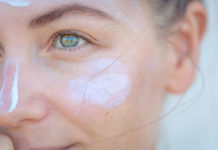
With natural and non-synthetic makeup and skincare becoming more in demand, here is a list of the Top 12 Ingredients to Avoid in Cosmetics.
Now more than ever, women are fine-tuning their skincare makeup routines to include better ingredients. This means no chemicals, toxins or synthetics. The makeup, skincare, shampoo and body lotions we use on our bodies can be harmful. These top 12 offenders found in everything from face washes, sunscreens, cosmetics and more have been linked to allergies, hormonal disruptions to cancer.
While there are certainly lots of studies and differing opinions on long-lasting effects some of these toxins have on our bodies, I think we can all agree that even by swapping some of our products with those that are more natural and non-synthetic, is a safe bet. Plus, your skin will be happy!
Top 12 Ingredients to Avoid in Cosmetics
1. BHA and BHT
This ingredient is often found in some lipsticks and moisturizers. The National Toxicology Program classifies butylated hydroxyanisole (BHA) as “reasonably anticipated to be a human carcinogen.” In some studies, it has been reported to produce liver damage and interfere with thyroid hormone levels. It’s found in exfoliators and some fragrances.
2. Coal Tar Dyes (Aminophenol, Diaminobenzene, Phenylenediamine)
Coal tar, a byproduct of coal processing, is a known human carcinogen, according to the National Toxicology Program and the International Agency for Research on Cancer. Hairstylists and other professionals are exposed to these chemicals in hair dye almost daily. Europe has banned many of these ingredients in hair dyes.
3. Formaldehyde
A potent preservative considered a known human carcinogen by the International Agency on Research on Cancer. Formaldehyde is known to be an asthma gene and neurotoxicant. This use has declined. But some hair straighteners are based on formaldehyde’s hair-stiffening action and release substantial amounts of the chemical. So, stay clear!
4. Parabens
This is an ingredient most of us have heard of for quite some time. Parabens are preservatives used in skin-care products to prevent contamination of products while they are sitting on the shelves. Although food and drug administrations have not deemed them to be fatal, according to the European Commission’s Scientific Committee on Consumer Products, longer chain parabens like propyl and butylparaben and their counterparts, isopropyl, and isobutyl parabens, may disrupt the endocrine system and cause reproductive and developmental disorders. Look for ingredients that are paraben-free.
5. Synthetic Fragrance
Fragrances are in everything from shampoo to deodorant to lotions. Since it’s not federal law, companies do not require them to list the chemicals in their fragrance mix. Recent research from the Environmental Working Group (EWG) and the Campaign for Safe Cosmetics found an average of 14 chemicals in 17 name brand fragrance products, none of them listed on the label. Fragrances are among the top five contenders that cause allergies, including causing rashes, irritation, and links to cancer and nervous system issues.
> Shop our Viva Winter Essentials <
Clean, Safe and None Toxic!
6. Sulfates
Sulfates (sodium lauryl sulfate) are commonly used surfactants, which are ingredients that cleanse the skin and hair in cleansers and shampoos but have been shown to cause or contribute to skin irritation, and can be a major disruptor of the skin’s natural oil balance. It is also widely said to cause acne.
7. Triclosan
Triclosan was very popular in the use of antibacterial products found in bars and liquids. However, it has been linked to thyroid issues, skin cancer, and allergies. Now, because of its potential link to these health concerns, the FDA has banned soaps and other antiseptic products from using the ingredient in 2017.
8. Phthalates
Phthalates are often found in nail polish and hairspray, deodorant and perfume and are meant to keep products soft and flexible. These chemicals have been known to cause endocrine disruption, headaches and respiratory problems. It’s advised that pregnant women avoid products with phthalates altogether. Look for products that indicate “phthalates-free” in their list.
9. Oxybenzone
Oxybenzone is one of the highest-risk chemicals found in sunscreen. Studies on cells and laboratory animals indicate that oxybenzone and its metabolites may disrupt the hormone system.
10. Propylene Glycol
According to the EWG, Propylene glycol is typically used as a skin-conditioning agent, however, it’s been linked to allergy-induced conditions such as dermatitis and hives.
11. Petrolatum
Petrolatum is mineral oil jelly (ex. petroleum jelly) that is often used as a barrier to lock moisture in the skin in a variety of moisturizers and also in hair care products to make your hair shine. However, although it’s been used for hundreds of years, it can become a health hazard if it hasn’t been refined.
12. DEA
DEA (diethanolamine) is used to make cosmetics creamy or sudsy and are mostly found in moisturizers and sunscreens, while cocamide and lauramide DEA are found in soaps, cleansers, and shampoos. They can cause skin irritation. The European Union classifies DEA as harmful on the basis of the danger of serious damage to health from prolonged exposure and deems it to be carcinogenic.












